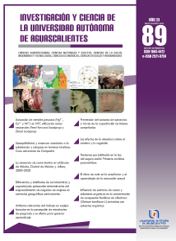Influence of sand substrates and organic solutions on the concentration of basil (Ocimum basilicum L.) phenolic compounds, extracted with organic solvents
DOI:
https://doi.org/10.33064/iycuaa2023894208Keywords:
Ocimum basilicum, acetone, compost, vermicompost, phenolic compounds, protected agricultureAbstract
The type of substrate and nutrient solution influence the content of antioxidants in plants for human consumption; however, the type of solvent used for the extraction of antioxidants can play a preponderant role in the results. The objectives of this study were to determine the accumulation of phenolic compounds (PC) of basil grown in two substrates with applications of four nutrient solutions under greenhouse conditions, and to evaluate the effect of three organic solvents in aqueous solution on the extraction of PC. The results showed that basil grown in sand with applications of a vermicompost nutrient solution had a PC concentration of up to 10.60 mg AG equiv/g BS, when extracted with acetone in aqueous solution.
Downloads
Metrics
References
• Alföldi, T., Granado, J., Kieffer, E., Kretzschmar, U., Morgner, M., Niggli, U., Schädeli, A., Speiser, B., Weibel, F., Wyss, G., Schmidt, W., & Schmidt, G. (2006). Quality and safety of organic products. FiBL Doss. 4, 2-24.
• Barbaro, L. A., & Karlanián, M. A. (2020). Efecto de las propiedades físicas del sustrato sobre el desarrollo de plantines florales en maceta. Ciencia del Suelo, 38(1), 01-11.
• Boeing, J. S., Barizão, É. O., e Silva, B. C., Montanher, P. F., de Cinque Almeida, V., & Visentainer, J. V. (2014). Evaluation of solvent effect on the extraction of phenolic compounds and antioxidant capacities from the berries: Application of principal component analysis. Chemistry Central Journal, 8(1), 08-48. doi: 10.1186/s13065-014-0048-1
• Calderón Bravo, H., Vera Céspedes, N., Zura Bravo, L., & Muñoz, L. A. (2021). Basil Seeds as a Novel Food, Source of Nutrients and Functional Ingredients with Beneficial Properties: A Review. Foods, 10(7), 1467. doi: 10.3390/foods10071467
• Houda Lezoul, N., Belkadi, M., Habibi, F., & Guillén, F. (2020). Extraction processes with several solvents on total bioactive compounds in different organs of three medicinal plants. Molecules, 25(20), 4672. doi: 10.3390/molecules25204672
• Gasaly, N., Riveros, K., & Gotteland, M. (2020). Phytochemicals: A new class of prebiotics. Revista Chilena de Nutrición, 4(2), 317–327. doi: 10.4067/S0717-75182020000200317
• González Solano, A., Rodríguez Mendoza, M. N., Trejo Telles, L., García Cue, J. L., & Sánchez-Escudero, S. (2011). Efluente y té de vermicompost en la producción de hortalizas de hoja en sistema NFT. Interciencia, 38(12), 863-869. Recuperado de http://www.redalyc.org/articulo.oa?id=33929617007
• Martínez Florián, P. & Roca, D. (2011). Sustratos para el cultivo sin suelo. Materiales, propiedades y manejo. En: V. J. Flórez R. (Ed.) Sustratos, manejo del clima, automatización y control en sistemas de cultivo sin suelo. (pp.37-78). Universidad Nacional de Colombia-Facultad de Agronomía. Bogotá (Colombia).
• Muñoz, W., Chavez, W., Pabón, L. C., Rendón, M. R., Patricia Chaparro, M., & Otálvaro Álvarez, Á. M. (2015). Extracción de compuestos fenólicos con actividad antioxidante a partir de Champa (Campomanesia lineatifolia). Revista CENIC Ciencias Químicas, 46, 38–46. Recuperado de https://www.redalyc.org/articulo.oa?id=181643224027
• Nguyen, P. M., & Niemeyer, E. D. (2008). Effects of nitrogen fertilization on the phenolic composition and antioxidant properties of basil (Ocimum basilicum L.). Journal of Agricultural and Food Chemistry, 56(18), 8685–8691. doi: 10.1021/jf801485u
• Prinsi, B., Morgutti, S., Negrini, N., Faoro, F., & Espen, L. (2019). Insight into composition of bioactive phenolic compounds in leaves and flowers of green and purple basil. Plants, 9(1), 22. doi: 103390/plants9010022
• Rojas Llanes, P. J., Martínez, J. R., & Stashenko, E. E. (2014). Contenido de compuestos fenólicos y capacidad antioxidante de extractos de mora (Rubus glaucus Benth) obtenidos bajo diferentes condiciones. Vitae, 21(3), 218–227. Recuperado de: https://www.redalyc.org/articulo.oa?id=169833713007
• Segura Castruita, M. A., Preciado Rangel, P., González Cervantes, G., Frías Ramírez, J. E., García Legaspi, G., Orozco Vidal, J. A., & Enríquez Sánchez, M. (2008). Adición de material pomáceo a sustratos de arena para incrementar la capacidad de retención de humedad. Interciencia, 33(12), 923-928.
• Snezana, F. (2017). Basil (Ocimum basilicum L.) a source of valuable phytonutrients. Int. J. Clin. Nutr. Diet, 3, 118. doi: 10.15344/2456
• Soto García, M., & Rosales Castro, M. (2016). Efecto del solvente y de la relación masa/solvente, sobre la extracción de compuestos fenólicos y la capacidad antioxidante de extractos de corteza de Pinus durangensis y Quercus sideroxyla. Maderas. Ciencia y Tecnología, 18(4), 701-714. doi: 10.4067/s0718-221x2016005000061
• Taie, H. A. A., & Radwan, S. (2010). Potential activity of basil plants as a source of antioxidants and anticancer agents as affected by organic and bio-organic fertilization. Notulae Botanicae Horti Agrobotanici Cluj-Napoca, 38(1), 119-127.
• Vázquez Vázquez, C., Ojeda Mijares, G., Fortis Hernández, M., Preciado Rangel, P., & Antonio González, J. (2015). Sustratos orgánicos en la producción de albahaca (Ocimum basilicum L.) y su calidad fitoquimica, Revista Mexicana de Ciencias Agrícolas, 6(8), 1833-1844. doi: 10.29312/remexca.v6i8.499
• Yang, L., Jiang, J. G., Li, W. F., Chen, J., Wang, D. Y., & Zhu, L. (2009). Optimum extraction process of polyphenols from the bark of Phyllanthus emblica L. based on the response surface methodology. Journal of Separation Science, 32(9), 1437-1444. doi: 10.1002/jssc.2008007404
Published
How to Cite
License
Copyright (c) 2023 María del Rosario Moncayo-Lujan, Mercedes Georgina Ramírez-Aragón, Tania Breshkovskaya Ortiz-Escobar, Tania Lizeth Guzmán-Silos, Miguel Ángel Segura-Castruita

This work is licensed under a Creative Commons Attribution-NonCommercial-ShareAlike 4.0 International License.
Las obras publicadas en versión electrónica de la revista están bajo la licencia Creative Commons Atribución-NoComercial-CompartirIgual 4.0 Internacional (CC BY-NC-SA 4.0)









